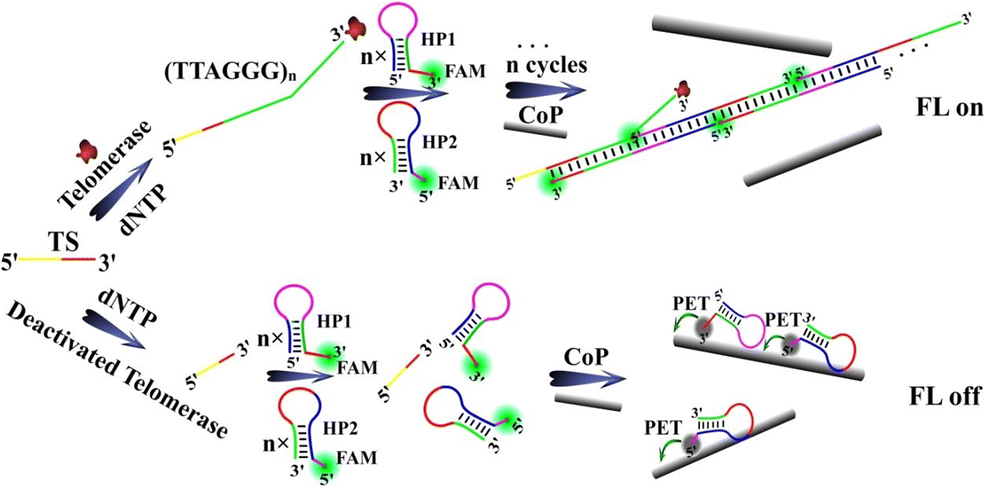当前位置:
X-MOL 学术
›
Microchim. Acta
›
论文详情
Our official English website, www.x-mol.net, welcomes your
feedback! (Note: you will need to create a separate account there.)
Cobalt phosphide nanowires for fluorometric detection and in-situ imaging of telomerase activity via hybridization chain reactions
Microchimica Acta ( IF 5.3 ) Pub Date : 2019-04-29 , DOI: 10.1007/s00604-019-3391-z Li Zhang , Jie Peng , Ming-Fang Hong , Jia-Qing Chen , Ru-Ping Liang , Jian-Ding Qiu
Microchimica Acta ( IF 5.3 ) Pub Date : 2019-04-29 , DOI: 10.1007/s00604-019-3391-z Li Zhang , Jie Peng , Ming-Fang Hong , Jia-Qing Chen , Ru-Ping Liang , Jian-Ding Qiu

|
AbstractThe authors describe cobalt phosphide (CoP) nanowires for use in sensitive fluorometric determination of the activity of the enzyme telomerase. A hybridization chain reaction (HCR) is applied to amplify the signal and carboxyfluorescein (FAM)-labelled hairpin probes (H1 and H2) are applied to match the telomeric DNA sequence. The CoP nanowires act as both the photoinduced electron transfer (PET) acceptor to induce fluorescence quenching, and also as an efficient probe carrier to facilitate telomerase imaging in living cells. The telomerase-triggered primer extension initiates an alternating hybridization reaction between H1 and H2. These result in the dissociation of FAM-labelled probes from CoP nanowires and thus an enhancement of the green fluorescence. The method is fairly simple and was applied to the detection of three types of cancer cells. The detection limit is as low as 7 cells (in case of HeLa cells). Conceivably, the method has a large potential in terms of inhibitor drug screening. Graphical abstractSchematic presentation of telomerase detection based on cobalt phosphide (CoP) nanowires and hybridization chain reaction (HCR). The telomerase-triggered primer extension can initiate the alternating hybridization reaction between carboxyfluorescein (FAM)-labelled hairpin probes (H1 and H2), and the generated long DNA duplex cannot be adsorbed on the CoP nanowires. This prevents the photoinduced electron transfer (PET) from FAM to CoP nanowires.
中文翻译:

磷化钴纳米线用于荧光检测和通过杂交链反应对端粒酶活性进行原位成像
摘要作者描述了磷化钴 (CoP) 纳米线,用于灵敏荧光测定端粒酶活性。应用杂交链反应 (HCR) 来放大信号,并应用羧基荧光素 (FAM) 标记的发夹探针(H1 和 H2)来匹配端粒 DNA 序列。CoP 纳米线既可以作为光诱导电子转移 (PET) 受体来诱导荧光猝灭,也可以作为有效的探针载体来促进活细胞中的端粒酶成像。端粒酶触发的引物延伸引发 H1 和 H2 之间的交替杂交反应。这些导致 FAM 标记的探针从 CoP 纳米线解离,从而增强绿色荧光。该方法相当简单,已应用于三种癌细胞的检测。检测限低至 7 个细胞(在 HeLa 细胞的情况下)。可以想象,该方法在抑制剂药物筛选方面具有很大的潜力。基于磷化钴 (CoP) 纳米线和杂交链反应 (HCR) 的端粒酶检测示意图。端粒酶触发的引物延伸可以启动羧基荧光素 (FAM) 标记的发夹探针 (H1 和 H2) 之间的交替杂交反应,生成的长 DNA 双链体不能吸附在 CoP 纳米线上。这可以防止光诱导电子转移 (PET) 从 FAM 到 CoP 纳米线。该方法在抑制剂药物筛选方面具有很大的潜力。基于磷化钴 (CoP) 纳米线和杂交链反应 (HCR) 的端粒酶检测示意图。端粒酶触发的引物延伸可以启动羧基荧光素 (FAM) 标记的发夹探针 (H1 和 H2) 之间的交替杂交反应,生成的长 DNA 双链体不能吸附在 CoP 纳米线上。这可以防止光诱导电子转移 (PET) 从 FAM 到 CoP 纳米线。该方法在抑制剂药物筛选方面具有很大的潜力。基于磷化钴 (CoP) 纳米线和杂交链反应 (HCR) 的端粒酶检测示意图。端粒酶触发的引物延伸可以启动羧基荧光素 (FAM) 标记的发夹探针 (H1 和 H2) 之间的交替杂交反应,生成的长 DNA 双链体不能吸附在 CoP 纳米线上。这可以防止光诱导电子转移 (PET) 从 FAM 到 CoP 纳米线。并且生成的长 DNA 双链体不能吸附在 CoP 纳米线上。这可以防止光诱导电子转移 (PET) 从 FAM 到 CoP 纳米线。并且生成的长 DNA 双链体不能吸附在 CoP 纳米线上。这可以防止光诱导电子转移 (PET) 从 FAM 到 CoP 纳米线。
更新日期:2019-04-29
中文翻译:

磷化钴纳米线用于荧光检测和通过杂交链反应对端粒酶活性进行原位成像
摘要作者描述了磷化钴 (CoP) 纳米线,用于灵敏荧光测定端粒酶活性。应用杂交链反应 (HCR) 来放大信号,并应用羧基荧光素 (FAM) 标记的发夹探针(H1 和 H2)来匹配端粒 DNA 序列。CoP 纳米线既可以作为光诱导电子转移 (PET) 受体来诱导荧光猝灭,也可以作为有效的探针载体来促进活细胞中的端粒酶成像。端粒酶触发的引物延伸引发 H1 和 H2 之间的交替杂交反应。这些导致 FAM 标记的探针从 CoP 纳米线解离,从而增强绿色荧光。该方法相当简单,已应用于三种癌细胞的检测。检测限低至 7 个细胞(在 HeLa 细胞的情况下)。可以想象,该方法在抑制剂药物筛选方面具有很大的潜力。基于磷化钴 (CoP) 纳米线和杂交链反应 (HCR) 的端粒酶检测示意图。端粒酶触发的引物延伸可以启动羧基荧光素 (FAM) 标记的发夹探针 (H1 和 H2) 之间的交替杂交反应,生成的长 DNA 双链体不能吸附在 CoP 纳米线上。这可以防止光诱导电子转移 (PET) 从 FAM 到 CoP 纳米线。该方法在抑制剂药物筛选方面具有很大的潜力。基于磷化钴 (CoP) 纳米线和杂交链反应 (HCR) 的端粒酶检测示意图。端粒酶触发的引物延伸可以启动羧基荧光素 (FAM) 标记的发夹探针 (H1 和 H2) 之间的交替杂交反应,生成的长 DNA 双链体不能吸附在 CoP 纳米线上。这可以防止光诱导电子转移 (PET) 从 FAM 到 CoP 纳米线。该方法在抑制剂药物筛选方面具有很大的潜力。基于磷化钴 (CoP) 纳米线和杂交链反应 (HCR) 的端粒酶检测示意图。端粒酶触发的引物延伸可以启动羧基荧光素 (FAM) 标记的发夹探针 (H1 和 H2) 之间的交替杂交反应,生成的长 DNA 双链体不能吸附在 CoP 纳米线上。这可以防止光诱导电子转移 (PET) 从 FAM 到 CoP 纳米线。并且生成的长 DNA 双链体不能吸附在 CoP 纳米线上。这可以防止光诱导电子转移 (PET) 从 FAM 到 CoP 纳米线。并且生成的长 DNA 双链体不能吸附在 CoP 纳米线上。这可以防止光诱导电子转移 (PET) 从 FAM 到 CoP 纳米线。































 京公网安备 11010802027423号
京公网安备 11010802027423号